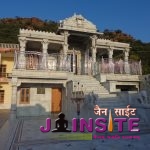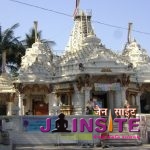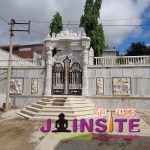SHRI INDRAPRASTH TIRTH
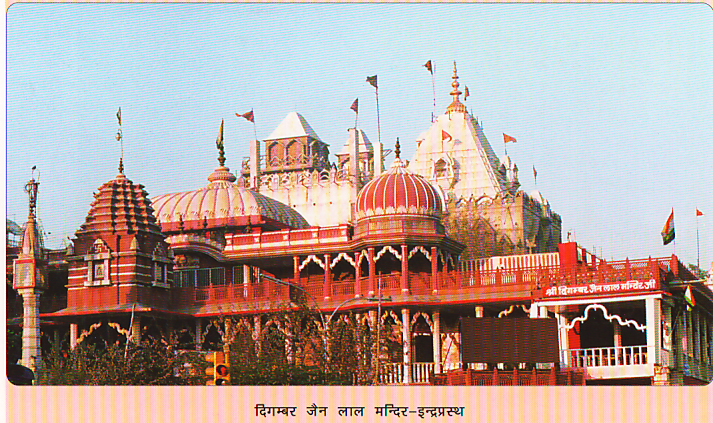
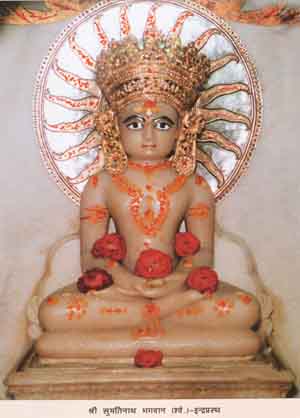
Presiding Deity and Location :
Sri Sumatinath Bhagwan in white color, seated in a lotus posture of height approx 38 Cms in a shrine located in Kinari Bazaar of Navgraha colony (Shve), and Sri Parshvanath Bhagwan in white color, seated in a lotus posture (Dig), in a shrine located in Chandni Chowk (Lal Mandir).
ANTIQUITY AND SALIENT FEATURES :
Indraprashtha of ancient times is not well known as Delhi, which has the privilege of being the capital city of the country from the beginning. It is stated that during the period of Sri Neminath Bhagwan Sri Pandavas had established their capital over here and built fort here as well. It is indicated that Indraprastha city was spread from the banks of river Yamuna to Mehrauli. Sri Pandavas were very much devoted and were proud of Jain culture and were ardent followers of Sri Neminath Bhagwan. It is said that the 12th renovation of Sri Shatrunjay shrine was carried out by Sri Pandavas and they attained Moksha from Mount Shatrunjay after practicing austerities along with numerous saints. It is doubtless that the devout Pandavas would have definitely constructed many temples in their capital city of Indraprastha. But none of these temples are in existence today. Probably during the course of time, as happened anywhere else, these temples would have been damaged and destroyed. Lot of ancient idols are discovered underneath the Earth and the remnants can be seen scattered at various places close by even today. It is said that during the rule of Thomar dynasty the city of Indraprastha was changed to Delhi. According to reference found in Vikram year 1223, during the time of king Madanpal of Thomar dynasty, Acharya Bhagwant Sri Jinchandrasurishvarji Maharaj was given a royal welcome when he arrived for Chaturmasya. Unfortunately, during his Chaturmas Acharya Bhagwant passed away and attained heavenly abode at a young age of 26 years on Bhadarva Krishna Chaturdasi. The final rites of Acharya were performed at a place accorded by the then ruling king Mehrauli with great honors amongst thousands of devotees. This place is existing even today while is well known as Dadawadi. The foot prints of Dada Gurudev is enshrined over here.
Acharya Bhagwant had done a lot of good deeds for the glorification of Jainism which are well known even today. In Vikram year 1305, Acharya Bhagwant Sri Jinlabsurishvarji had composed the first “Aanga” over here. On Bhadarva Krishna Dasami in Vikram year 1389 the composition “Vividh Tirth Kalpa” by Acharya Sri Jinprabha-surishvarji was completed here. In the view point of history this composition is one of the significant and very useful one, which is available even today. It is stated that during the pravesh of Acharya Bhagwant in the month of Vaishakh, a temple was ceremonially consecrated by his hands. During that period Emperor Hamir Mohamed was the ruler. The villages Mathand and Varah were gifted by the Emperor for the temple.. It is stated that the emperor on being impressed by the religious discourses given by the Acharya proclaimed to safe guard the shrine by of Girnar and Shatrunjay. Later from time to time, Chaturmas of several Swetamber and Digamber Acharyas took place here. According to reference found, many temples were constructed here, a lot of Tirhmalas were composed here and the temples of this place were mentioned in several “Tirthmalas”. It is also stated that lot of pilgrimage tours to Mount Shatrunjay and Girnar were taken from here perhaps a lot of temples would have been constructed here, but at present the temple of Sri Sumathinath Bhagwan ( Shve), and the Lal Mandir of Sri Parshvanath Bhagwan (Dig) are the most ancient ones. It is believed that the temple of Sri Sambhavanth Bhagwan (Shve) which is close to the temple of Sri Sumatinath Bhagwan (Shve) is of the same period. It is also believed that the temple of Sri Sumathinath Bhagwan (Shve) is of period earlier that 1500 years. The well known ancient art of this temple and the hand made painting in gold, prove the antiquity of this place. The description of the above can be found in world wide guides and a lot of students and tourists from abroad visit this place.
The temple of Sri Parshvanath Bhagwan (Dig) is said to be of the period of Mughals, which is approx. earlier than 800 years. It is stated that the construction of this massive temple was done by a Digamber devotee, an Army person. During the last renovation to this temple which was carried out in Vikram year 1935, red walls were constructed. Hence the name “Lal Mandir”. Before this, the temple was called as Rathi Ke Kuche ka Mandir” Urdu Mandir and Lash Kari Mandir.
During the period of Aurangzeb, Nagaada (Drums) used to be played in the temple. He ordered to discontinue the same, but the Nagaada played on itself, which is a miraculous and unbelievable incident.
The prime significance of this place, which is the period of Sri Neminath Bhagwan is that it was established as the capital city of India by Sri Pandavas who were the chief followers of Prabhu. It still remains to be the capital of the country.
This is the Samadhi place of Manidhari Dada Gurudev Acharya Bhagwant Sri Jinachandrasurishvarji and at the place of final rites, the ancient foot-prints are enshrined ceremonially for the benefit of devotees. This adds to the significance of this place. Acharya Bhagwant’s ancient foot-prints at such an ancient place is very difficult to be found anywhere else. Thousands of devotees continuously visit this place and the desires of the pious devotees gets fulfilled here.
The Tirthmala “Vividh TirthKalp” composed by Acharya Bhagwant Sri Jinprabhsurishvarji is very popular and very useful today, and since this was finalized at this place, it has added extra importance.
The paintings of gold, library offhand-written religious books and the art of the Swetamber temple here are all very appealing. Ancient artistic ruins and specimens are seen scattered near Mehrauli and Qutab-Minar. Specimens of various ancient Jain art can be seen at Qutab-Minar.
Apart from this, there is a Swetamber and Digamber temple. Besides Mehrauli Dadawadi, there is one more Dadawadi of Dada Sri Jinkushalsurishvarji and Athma Vallabh Smarak Guru Mandir.
Thousands of years old idols in this Lal Digamber Mandir are worth seeing. Lot of pilgrims and tourist from India and abroad come over here.
APPROACH – ROUTE :
This being the capital city of India, rails, uses and airplanes go to every part of India. There are aero planes to go to any part of the world too.
From this Swetamber and Digamber temples, New Delhi is approx. 3 Kms away and the Old Delhi is just a Km away. There is a tar road upto the temple and cars, buses can go upto the temple. The airport of this city is approx. 20 Kms away from here. Autos, taxis are available from any part of the city.
AMMENITIES FOR JAIN PILGRIMS :
There is a dharamshala near the Swetamber temple with all facilities. The construction work of bhojanshala is in progress. Dharamshalas and Bhojanshala are available at both Dadawadis and at Athma Vallabh Smarak Guru Mandir.
Near Digamber temple too there is a dharamshala and guest house with all facilities. Near Digamber Jain Bhavan-Favvaram there is a bhojanshala.
Managed By :
Shri Sumathinath Bhagwan (Shve) Jain Mandir, Sri Jain Swetamber Mandir & Paushal Charitable Trust.
1997, Naughara Kinari Bazaar,
Delhi – 110 006
Tel : 011-3270489
Shri Parshvanath Digamber Jain Lal Mandir.
Chandni Chowk,
Delhi – 110 006
Tel : 011 – 3280942


